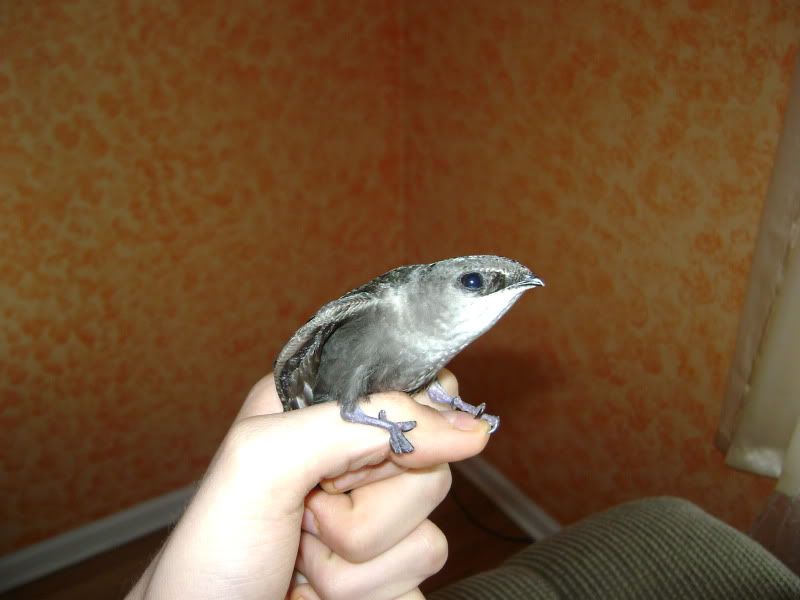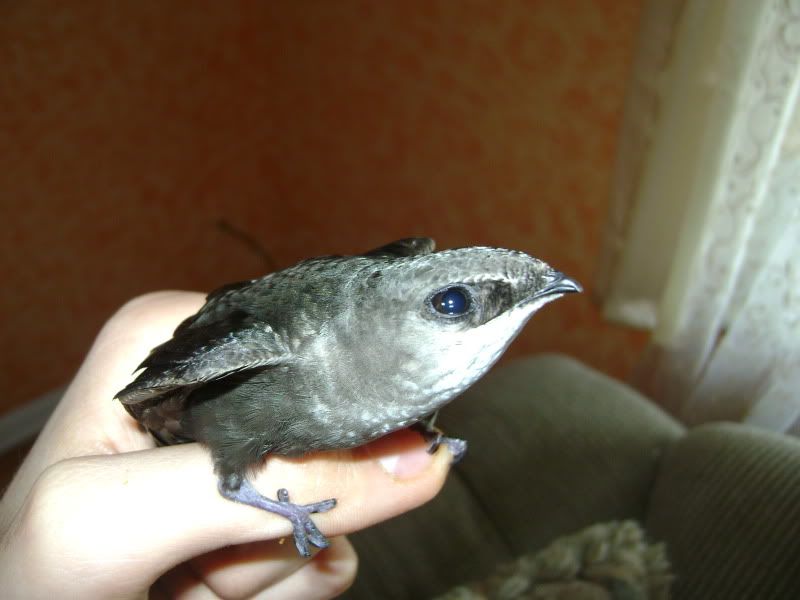What bird is this?
- Thread starter Aztek
- Start date
- Joined
- Sep 8, 2003
- Messages
- 1,711
Looks like what we call Nightjars. VERY cute critter anyway.
- Joined
- May 1, 2004
- Messages
- 2,290
That's not a "nightjar", as those are the group of birds which include the Whip-poor-Will and Frogmouth, and those are much larger than this little guy. This is, in fact, a Chimney Swift(Chaetura pelagica}, a ravenous devourer of mosquitos, which often build their nests inside of chimneys, hence the name. They are very common birds here where I live, though in flight they are often mistaken for bats, since they take off at dusk to feed and can perform some remarkable aerial acrobatics in pursuit of flying insects.
You can read more about them here: http://images.google.com/imgres?img...&prev=/images?q=chimney+swift&hl=en&sa=N&um=1 and also here:
http://bna.birds.cornell.edu/bna/species/646/articles/introduction .
pitbulllady
You can read more about them here: http://images.google.com/imgres?img...&prev=/images?q=chimney+swift&hl=en&sa=N&um=1 and also here:
http://bna.birds.cornell.edu/bna/species/646/articles/introduction .
pitbulllady
Stop holding it like that, You will rip out all it's wing feathers and tail feathers. Could be a juvie and doesn't have adult coloring yet, not sure what it is.
Thank you.That's not a "nightjar", as those are the group of birds which include the Whip-poor-Will and Frogmouth, and those are much larger than this little guy. This is, in fact, a Chimney Swift(Chaetura pelagica}, a ravenous devourer of mosquitos, which often build their nests inside of chimneys, hence the name. They are very common birds here where I live, though in flight they are often mistaken for bats, since they take off at dusk to feed and can perform some remarkable aerial acrobatics in pursuit of flying insects.
You can read more about them here: http://images.google.com/imgres?img...&prev=/images?q=chimney+swift&hl=en&sa=N&um=1 and also here:
http://bna.birds.cornell.edu/bna/species/646/articles/introduction .
pitbulllady
- Joined
- Jul 12, 2007
- Messages
- 1,124
The odd head shape helps them to locate insects on the wing (via tactile and echo-location). These birds only really land for nesting, other than that they spend most of their lives flying and do everything on the wing! That's why they have those goofy tiny little feet.
I hope you aren't keeping this bird, they are really not cage type of birds.
I hope you aren't keeping this bird, they are really not cage type of birds.
- Joined
- May 1, 2004
- Messages
- 2,290
You are welcome. And as you can see, the way you(assuming that was your hand) were holding the Chimney Swift IS the recommended way to hold small wild songbirds safely, without harming their flight feathers, since it prevents them from struggling and doing harm to themselves. Way back in the day, I spent a summer working for the Youth Conservation Corps at a nearby National Wildlife refuge, and one of our tasks was mist-netting and banding native song birds, including Bluebirds and a species related to the Chimney Swift, the Barn Swallow. This is how we were taught to hold the birds for examination and banding by biologists. We had to band waterfowl, too, including Canada Geese, which were a REAL handful(give me a mad cornered bobcat any day over a Canada Goose with a nest), and we had to pin their wings behind them, over their backs, with one hand while gripping their necks with the other; it looked bad, but it did not hurt the birds, and it kept THEM from hurting US. Anyone who has ever dealt with an angry goose can relate, I'm sure!
Thank you.
pitbulllady
Makes sense.The odd head shape helps them to locate insects on the wing (via tactile and echo-location). These birds only really land for nesting, other than that they spend most of their lives flying and do everything on the wing! That's why they have those goofy tiny little feet.
I hope you aren't keeping this bird, they are really not cage type of birds.
And no, I just grabbed it to take it outside.
:? :? :? OverloadYou are welcome. And as you can see, the way you(assuming that was your hand) were holding the Chimney Swift IS the recommended way to hold small wild songbirds safely, without harming their flight feathers, since it prevents them from struggling and doing harm to themselves. Way back in the day, I spent a summer working for the Youth Conservation Corps at a nearby National Wildlife refuge, and one of our tasks was mist-netting and banding native song birds, including Bluebirds and a species related to the Chimney Swift, the Barn Swallow. This is how we were taught to hold the birds for examination and banding by biologists. We had to band waterfowl, too, including Canada Geese, which were a REAL handful(give me a mad cornered bobcat any day over a Canada Goose with a nest), and we had to pin their wings behind them, over their backs, with one hand while gripping their necks with the other; it looked bad, but it did not hurt the birds, and it kept THEM from hurting US. Anyone who has ever dealt with an angry goose can relate, I'm sure!
pitbulllady


